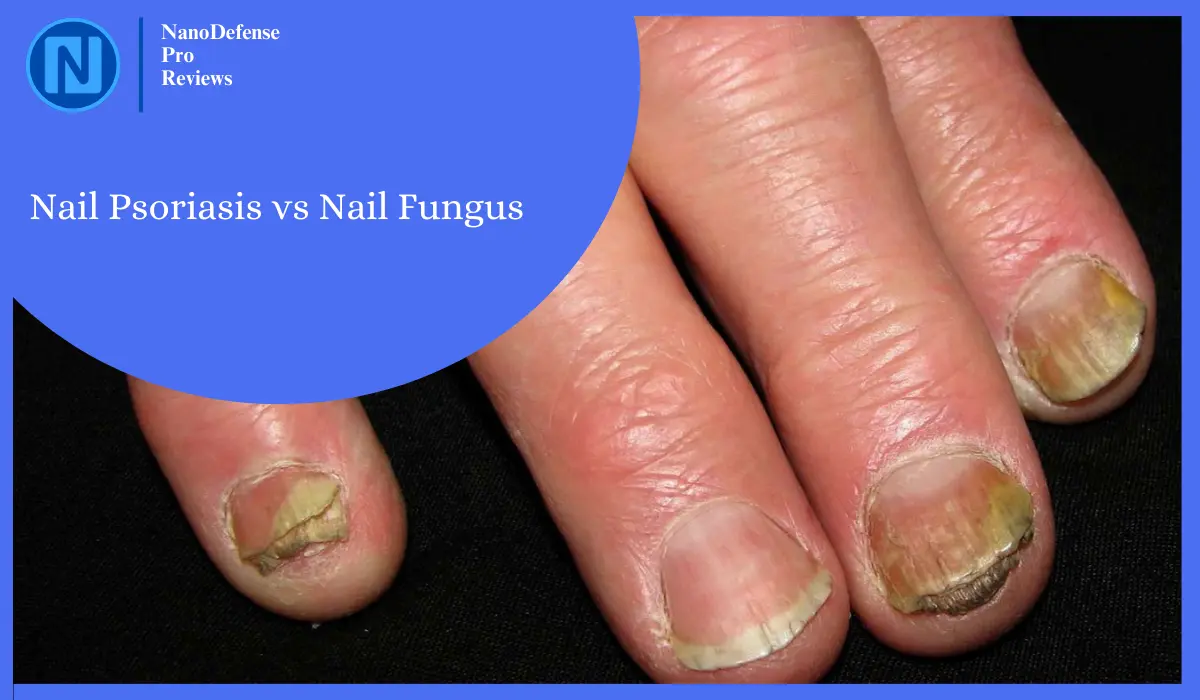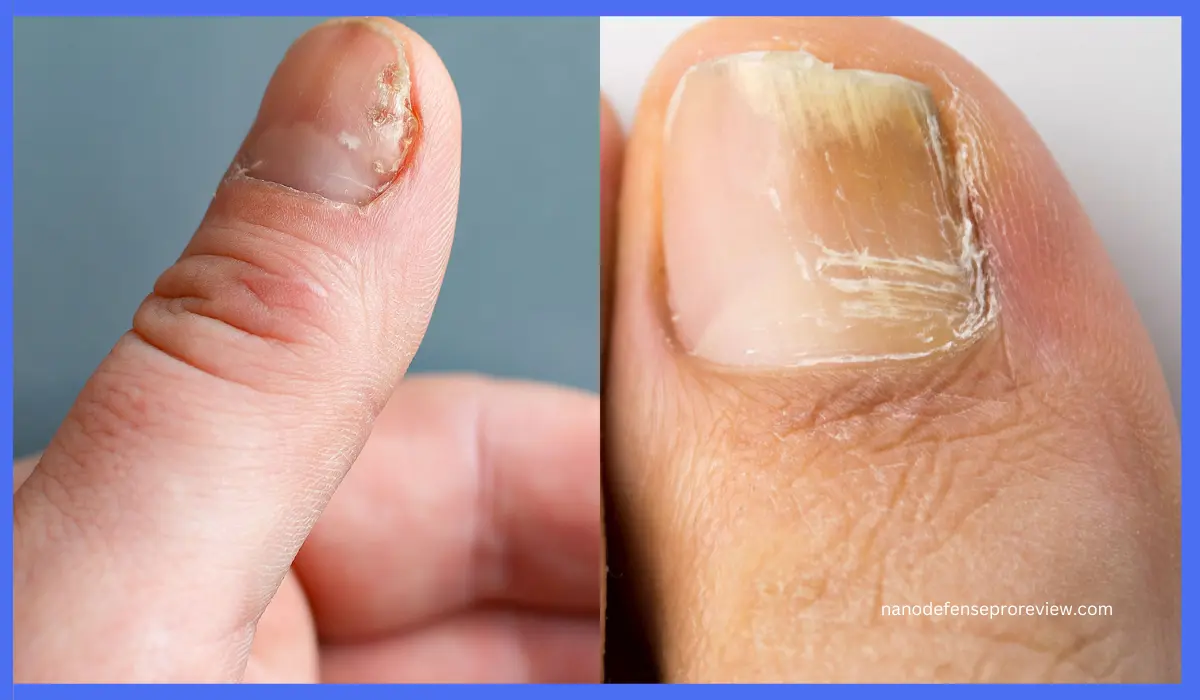How To Distinguish Nail Psoriasis vs Nail Fungus? 7 Key Differences!
Nail psoriasis is a systemic condition in which the skin, and therefore also the nails, grows too fast. Nail fungus starts from an infection and is more common in the toenails.

Disclaimer: This article has been generated with the assistance of AI tools. While our research team has fact-checked the content, readers should independently verify information for accuracy and reliability.
Nail conditions can be a source of discomfort and embarrassment, and two of the most common culprits are nail psoriasis and nail fungus. While these conditions may share some similarities in appearance, they have distinct differences in their causes, symptoms, and treatments. Understanding how to distinguish between nail psoriasis and nail fungus is crucial for receiving the appropriate care and managing the condition effectively.
Location Of Nail Psoriasis vs Nail Fungus

The location of nail psoriasis and nail fungus can provide valuable insights into distinguishing between the two conditions:
Nail Psoriasis: Nail psoriasis commonly affects the fingernails more than the toenails. It tends to cause symptoms like yellowing or browning of the nails, detachment of nails from the nail bed, chalky buildup under the nails, and tenderness or pain if there’s buildup under the nails. Psoriasis can also manifest as red, scaly patches of skin on other parts of the body, indicating a systemic condition.
Nail Fungus: On the other hand, nail fungus typically starts in one nail and can spread if left untreated. Fungal infections are more common in toenails due to the warm, moist environments they provide, like sweaty socks and shoes. Unique symptoms of nail fungus include nail darkening, progressive nail shape changes, brittle or dull nails, and sometimes a foul odor.
Understanding the location of the nail condition can be a crucial factor in differentiating between nail psoriasis and nail fungus. While nail psoriasis often affects the fingernails and can be associated with systemic symptoms, nail fungus tends to start in one nail and is more common in toenails due to the favorable environment for fungal growth in moist and warm conditions. Consulting a healthcare provider for a proper diagnosis and treatment plan is essential when experiencing nail abnormalities.
Odor Of Nail Psoriasis vs Nail Fungus
The presence or absence of odor can be a distinguishing factor between nail psoriasis and nail fungus:
- Nail Psoriasis: Nail psoriasis typically does not cause an unpleasant odor. Psoriasis of the nails is characterized by symptoms like yellowing or browning of the nails, detachment of nails from the nail bed, chalky buildup under the nails, and tenderness or pain if there’s buildup under the nails. Psoriasis often affects multiple nails, including both fingers and toes, and is associated with systemic symptoms like red, scaly skin patches elsewhere on the body.
- Nail Fungus: In contrast, nail fungus is often associated with a foul odor. Fungal nail infections can lead to symptoms like nail darkening, progressive nail shape changes, brittle or dull nails, and sometimes a foul smell. Fungal infections usually start in one nail and can spread if left untreated, commonly affecting toenails due to the warm, moist environments they provide.
Understanding the presence or absence of odor can be a helpful indicator in differentiating between nail psoriasis and nail fungus. While nail psoriasis typically does not cause an odor, nail fungus is often linked to a foul smell.
Other Symptoms Of Nail Psoriasis vs Nail Fungus
In addition to the differences in location and odor, nail psoriasis and nail fungus exhibit distinct symptoms that can aid in their distinction:
Nail Psoriasis Symptoms
- Pitting: Nail psoriasis often causes pitting, with irregular small divots on the nail surface.
- Detachment: Psoriasis can lead to the nail separating from the nail bed (onycholysis)[Source: Cleveland Clinic], with a red streak under the nail before the white portion.
- Chalky buildup: Nail psoriasis sometimes causes too much keratin to grow under the nail, leading to a white, chalky substance under the nail.
- Tenderness or pain: If there’s buildup under the nails, it can cause tenderness or pain.
- Nail loss: Psoriasis is more likely than a fungus to make the nails detach from their beds, leading to nail loss.
- Systemic symptoms: Nail psoriasis is often accompanied by other symptoms of psoriasis like red, scaly skin patches elsewhere on the body.
Nail Fungus Symptoms
- Nail color changes: Fungal infections can cause hyperpigmentation, or changes in the color of the nail, starting as a faint gray, greenish, or brown spot that gets darker and wider over weeks or months.
- Nail shape changes: Fungal infections can lead to progressive nail shape changes.
- Brittleness or dullness: Fungal infections can cause nails to become brittle or dull.
- Foul odor: Fungal nail infections are often associated with a foul odor.
- Athlete’s foot symptoms: Fungal infections can sometimes spread between the toes and onto the skin on the feet, leading to athlete’s foot symptoms like itchy, cracked skin on the feet[Source: Mayo Clinic].
Understanding these additional symptoms can help in distinguishing between nail psoriasis and nail fungus, as they are indicative of the underlying causes and mechanisms of the conditions.
Nail Appearance Of Nail Psoriasis vs Nail Fungus
The appearance of nails affected by nail psoriasis and nail fungus can provide valuable insights into distinguishing between the two conditions:
Nail Psoriasis
- Nail Pitting: Nail psoriasis often causes pitting, which is small divots or dimples on the surface of the nail. These pits can be irregular in shape and distribution, resembling tiny dents in the nail.
- Onycholysis: Another characteristic feature of nail psoriasis is onycholysis, where the nail separates from the nail bed, often with a red streak underneath the nail before the white portion.
- Nail Discoloration: Nail psoriasis can lead to discoloration of the nails, with white, yellow, or brown patches or streaks.
- Nail Thickening: In some cases, nail psoriasis can cause thickening of the nails, making them appear thicker than usual.
Nail Fungus
- Discoloration: Fungal nail infections are often associated with yellow, green, or brown discoloration of the nails. The color changes can be widespread and progressive, affecting the entire nail.
- Thickening and Crumbling: Nail fungus can lead to thickening and brittleness of the nails, with a tendency to crumble or become distorted.
- Odor: Fungal infections are often linked to a foul odor, which can be a distinguishing feature of nail psoriasis.
- Nail Shape Changes: Fungal infections can cause progressive changes in the shape of the nails, leading to distortion and irregularities in nail appearance.
Causes Of Nail Psoriasis vs Nail Fungus
The causes of nail psoriasis and nail fungus are distinct, contributing to the differences in these conditions:
Nail Psoriasis
- Autoimmune Condition: Nail psoriasis is an autoimmune disease where the immune system overreacts, leading to rapid skin cell growth. This excessive cell growth results in characteristic symptoms like discoloration, pitting, and changes in the nails.
- Psoriatic Rash: Nail psoriasis often appears alongside a psoriatic rash on other parts of the body, indicating a systemic condition.
- Genetic Predisposition: While anyone can develop nail psoriasis, individuals with a genetic predisposition to psoriasis are more likely to experience nail involvement.
Nail Fungus
- Fungal Infection: Nail fungus, known as onychomycosis, is a localized infection caused by fungi that affect the tissues in and around the nails. Fungi like molds and yeasts thrive in warm, moist environments and feed off keratin, the main protein in nails.
- Contagious Nature: Unlike psoriasis, nail fungus is contagious and can spread from person to person or from one body part to another, such as from athlete’s foot to the nails.
- Risk Factors: People with existing conditions like diabetes or HIV/AIDS, as well as those with poor hygiene practices or frequent exposure to damp environments, are at higher risk of developing nail fungus.
Understanding the underlying causes of nail psoriasis and nail fungus is crucial in differentiating between the two conditions. While nail psoriasis stems from an autoimmune response leading to rapid skin cell growth, nail fungus is caused by fungal infections that thrive in warm, moist environments and affect the nails by feeding off keratin. Seeking medical advice for an accurate diagnosis and appropriate treatment is essential when experiencing nail abnormalities associated with these conditions.
Risk Factors About Nail Psoriasis vs Nail Fungus
The risk factors associated with nail psoriasis and nail fungus highlight key differences in their causes and susceptibility:
Risk Factors For Nail Psoriasis
- Genetic Predisposition: Nail psoriasis is often linked to a genetic predisposition to psoriasis, with about 90% of individuals with psoriasis developing psoriatic nails at some point in their lifetime.
- Psoriatic Arthritis: Nail psoriasis can also be an early indication of psoriatic arthritis, affecting around 30% of people with psoriasis.
- Systemic Psoriasis: Individuals with psoriasis and psoriatic arthritis are more prone to nail psoriasis, which can manifest as nail changes alongside skin symptoms.
- Severity of Psoriasis: More severe skin disease in individuals with psoriasis may increase the likelihood of developing nail psoriasis.
Risk Factors For Nail Fungus
- Fungal Environment: Fungi thrive in warm, moist environments, making areas like pool decks, locker rooms, and sweaty socks and shoes ideal for fungal growth.
- Contagious Nature: Nail fungus is contagious and can spread from person to person or from one body part to another, such as from athlete’s foot to the nails.
- Immune System Suppression: Individuals with a suppressed immune system, such as those with diabetes or HIV/AIDS, are at higher risk of developing nail fungus.
- Poor Hygiene Practices: Poor hygiene, especially in damp or sweaty conditions, can increase the risk of contracting nail fungus.
Treatments Of Nail Psoriasis vs Nail Fungus
The treatments for nail psoriasis and nail fungus differ significantly due to their distinct underlying causes:
Nail Psoriasis Treatment
- Topical corticosteroids: These medications help reduce inflammation and are often the first-line treatment for nail psoriasis.
- Intralesional corticosteroid injections: Corticosteroids may be injected directly into the nail matrix (root) to treat severe nail psoriasis.
- Immunosuppressive drugs: Medications that suppress the overactive immune system, such as methotrexate or cyclosporine, can be used to treat nail psoriasis.
- Biologic drugs: Newer biologic medications that target specific parts of the immune system, like TNF-alpha inhibitors, can be effective for severe nail psoriasis.
Nail Fungus Treatment
- Topical antifungal medications: These are applied directly to the affected nail and surrounding skin. Examples include ciclopirox and amorolfine.
- Oral antifungal medications: Systemic antifungal drugs like terbinafine or itraconazole are often prescribed for more severe or widespread fungal nail infections.
- Laser or photodynamic therapy: These newer treatments use laser light or a combination of light and a photosensitizing agent to kill the fungus.
- Surgical removal of the nail: In some cases, the entire infected nail may need to be removed to allow a new, healthy nail to grow in its place.
It’s important to note that while nail psoriasis is a chronic condition that requires long-term management, nail fungus can often be cured with appropriate treatment. However, in some cases, nail psoriasis and nail fungus can coexist, and a combination of treatments may be necessary. NanoDefense Pro is a topical solution that may help treat nail fungus, but it is not indicated for nail psoriasis.
Seeking professional medical advice is crucial for an accurate diagnosis and the development of an effective treatment plan tailored to the individual’s specific condition and needs.
As A Final Point
Distinguishing between nail psoriasis and nail fungus is essential for receiving the most appropriate treatment and care. While both conditions can cause nail changes, they differ in their location, associated symptoms, nail appearance, causes, and risk factors.
If you suspect you have either nail psoriasis or nail fungus, consult a dermatologist or healthcare provider for an accurate diagnosis and personalized treatment plan. With proper care and management, it is possible to improve the health and appearance of your nails and prevent the condition from worsening or spreading.

Lisa Miller
Dr. Lisa Miller is a board-certified Dermatologist with over 15 years of experience treating a wide range of skin, hair, and nail conditions. She received her medical degree from the prestigious Columbia University College of Physicians and Surgeons and completed her dermatology residency at the University of California, San Francisco, one of the top dermatology training programs in the country. Dr. Miller is an active member of the American Academy of Dermatology and has authored numerous peer-reviewed articles and book chapters on the latest advancements in dermatological care. She is frequently invited to speak at national and international medical conferences, sharing her expertise with other clinicians. In her private practice, Dr. Miller takes a patient-centered approach, collaborating closely with each individual to develop customized treatment plans. She is passionate about empowering her patients to achieve optimal skin, hair, and nail health through a combination of the latest medical therapies and lifestyle recommendations.
